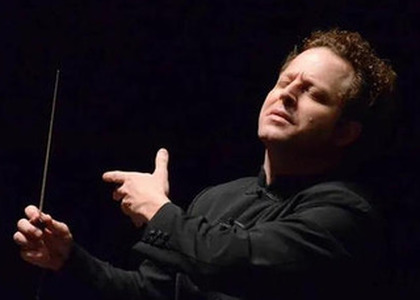> [Archived] Interviews

Interview with conductor John Axelrod
Today, March 22nd, starting at 19:00, conductor John Axelrod will lead the Bucharest Symphony Orchestra in an extraordinary concert that will take place at the Romanian Athenaeum. On this occasion, the American musician, who is the principal conductor of the Bucharest Symphony Orchestra, gave an interview to our colleague, Ioana Țintea.
John Axelrod, to begin with, I would like you to tell me why you chose to collaborate with the Bucharest Symphony Orchestra?
The Bucharest Symphony Orchestra is a remarkable ensemble, a Romanian culture gem. It is made up of the best musicians who currently work in the most popular orchestras in Bucharest. They are instrumentalists from the "George Enescu" Philharmonic Orchestra, of the Radio Orchestras or the Romanian National Opera in Bucharest , along with other artists. They come together for various important projects like the one that we are presenting today at the Romanian Athenaeum.
Considering the past collaborations, how do you describe the Bucharest Symphony Orchestra, knowing that it was originally thought of as a project orchestra, dedicated to the crossover repertoire and now we see a new orientation, towards symphonic music?
The important term here is "repertoire", and I don't think it's necessarily a crossover. I think they understood the idea that by doing special projects, it gives them flexibility and the opportunity to go to a repertoire that maybe some ensembles can't program in their current season. But, of course, they are the same musicians who work in different orchestras that organize works from the basic classical music repertoire. So, it is understandable that when we have a project like the one that we have today, we organize it for a certain purpose. And the purpose of this project is to present to the public the two versions of the Fourth Symphony by Robert Schumann, together with the Concerto for violin and orchestra by Johannes Brahms, and to record this unique juxtaposition. Why? Schumann is the only composer in the history of music who created two versions of the same symphony, due to his mental disorders. Today that mental health condition is known as bipolar affective disorder. But in the 19th century people didn't know what to name it, so Schumann reflected this duality in the two characters that he created: Florestan and Eusebius, who represented the author's emotional opposites. Florestan is the euphoric, manic and energetic personality, while Eusebiu embodies the dark and depressive side of the composer. At the time he wrote the first version of the Symphony in D minor he was married and his daughter had just been born. At that time he composed many works, including Symphony I. The publisher didn't want to publish the first version of Symphony IV because it would have been too similar to the first symphony. 10 years later, in 1851, he revised the Symphony in D minor's score, rewrote it being influenced by Eusebiu's personality, by the changes in the compositional and interpretative ideas that were taking place at that time - the Italian style, late classicism and the period of German romanticism with its serious and dark tonalities. This version was published under the title Fourth Symphony. It would be another 50 years before Brahms himself convinced Breitkopf und Härtel to publish the early version of this Symphony in 1891. So, thanks to Brahms, Schumann and Clara Schumann, we have two versions of the same symphony, which provides a unique opportunity for musicians and audiences alike to listen to two different forms of the same works. Among them we have the Concerto for violin and orchestra by Brahms, performed by the young Bilal Alnemr, a wonderful artist and Ambassador of the "Classeek" program.
What does the partnership with "Classeek" mean for the Bucharest Symphony Orchestra?
Classeek is a social network for musicians, but it's also a performance education and music development program. They are international artists and also ambassadors. They nominate young performers who are fit for a successful career. We saw this program as an opportunity and created this partnership with the Bucharest Symphony Orchestra, through which we offer professional engagements to young soloists. At the same time we also have strong visibility due to this partnership with Classeek, so it's a win-win situation.
Finally, I would like you to tell us about the future recording projects that you want to create together with the Bucharest Symphony Orchestra.
I can't tell you what the future holds, but I can describe the present. The recording that we will make of Schumann's Fourth Symphony is one of many recordings we wish to make in the future. This one will be unique because there is no other record material in which the two versions of the symphony are performed together. As I said before, it is not only about the portrait of Schumann's mental condition, but also an illustration of a love story. In 1840, when he began writing his work, Robert Schumann was full of energy, excited and eager to compose. The love story between him and Clara is transposed, as well as the challenges that they faced in order to be able to get married. Their love survived despite the disapproval of Clara's parents and they even had to fight her father in court in order to marry him and if they waited one more day, Clara would have turned 21 and the parental approval was no longer required to marry. But for them it was a matter of love. All this energy and depth of love for Clara are reflected in the original version of the Symphony, and in the rewritten version, the one from 1851. One finds the bittersweet taste of romantic love that belongs to a man who is willing to die for love, which happened. Robert Schumann actually died of love.
Translated by Ioana Negrea,
University of Bucharest, Faculty of Foreign Languages and Literatures, MTTLC, year II
Corrected by Silvia Petrescu














